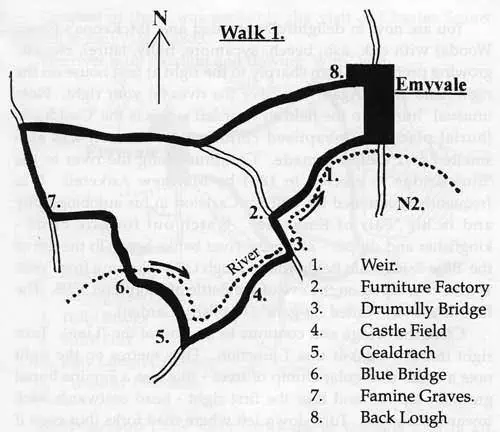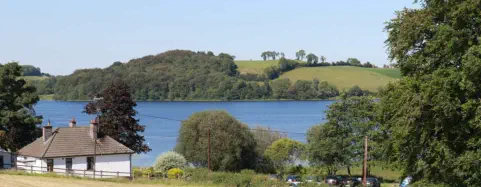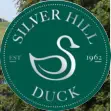

All Content Copyright emyvale.net


Walking
Almost 20 years ago Emyvale Development Association prepared a number of Walks around Emyvale, suggesting that people could
select one of them and complete the walk and watch out for the various sights along the way as highlighted by us. At the time we
produced a little Booklet containing the Walks and I have decided to post the walks again and perhaps some might enjoy reading
about them if not actually doing the Walking. We started all the Walks at the Leisure Centre.
Walk 1 (4 Mile in Length)
The Leisure Centre, which was built 1981-1985, on the site of a former Methodist Meeting House which had been erected in 1836.
A Patrick Murphy taught a Hedge-school here for Catholics
and Protestants in 1837.
Opposite Centra is where the Old Emyvale Inn was and it
was there that the Dublin Derry Mail coach stopped and
changed horses and had food. Irish scholar, John
O’Donovan, stopped there in 1835.
The Oratory comes next on the left hand side. This used to
be the Courthouse where Petty Sessions were held every
fortnight. It was burned down by the Irish Volunteers
during the War of Independence in 1921.
On the opposite side you will see the High House where, in
1959 during renovations, a Bronze Age tomb was
unearthed under the kitchen floor, which indicated that
people lived here some three thousand years ago.
Next you come to the Bridge at the bottom of the town
where you will turn right. The present bridge replaced the
Old Bridge in 1994.As you head out the road notice that
the main river is on the left and the Mill Race is on the
right. The Mill Race was built about 1810 to feed into Emy
Lake to provide power for the Mills at Emy and Mullan.
When you cross the small bridge you will have both rivers
on your left until you come to the weir where they
separate. The Hill on your right is Scarnageeragh Hill,
which was one of McKenna’s seven hills and had a Ring
Fort originally.
Carry on until you come to a T junction and turn left here at Gola, formerly Woodlands Furniture and formerly McCreedy’s. It was a
Scutch Mill before the furniture.
Carry on to Drumully Bridge which was built before the Emyvale bridge. When you cross the bridge you will see a very attractive
restored gate-house on the right and the walls and gate posts which were the entrance to the original Anketell Grove. Turn right
her up the New Line. A large field to the left is called the Castle Field where McKenna had a Castle in 1592. You now pass through
a beautiful weeded area with oak, ash, beech, sycamore, holly, laurel, etc etc.
Turn a sharp right at the first house on the right. Look into a field on the left to see a mound which is called ‘the Cealdrach’ (burial
place for unbaptised children) and there was iron smelted and weapons made here.
Continue along the river past a house of the left and you will reach the ‘Blue Bridge’, which was erected in 1801 by Matthew
Anketell and it is mentioned by William Carleton in ‘The Fair of Emyvale’. On the left of the bridge is where Hugh O’Neill’s army
encamped on the eve of the Battle of Clontibret 1595. The field is called ‘Sigara’ ( The fairy Garden).
Cross the bridge and continue to the end of the Line, turn right at the T junction, On the right in a clump of trees was a Famine
Burial ground.
Up the Hill and take the first right back towards Emyvale. At a fork in the road take a left and this will take you straight back to the
village. As you go up the steep hill the ‘Back Lough’ is on you left and you pass the housing estates of Lake View and Oriel Park
before arriving back to Main Street.

Walk 2. HERE 




All Content Copyright emyvale.net



Walking
Almost 20 years ago Emyvale Development Association prepared
a number of Walks around Emyvale, suggesting that people
could select one of them and complete the walk and watch out
for the various sights along the way as highlighted by us. At the
time we produced a little Booklet containing the Walks and I
have decided to post the walks again and perhaps some might
enjoy reading about them if not actually doing the Walking. We
started all the Walks at the Leisure Centre.
Walk 1 (4 Mile in Length)
The Leisure Centre, which was built 1981-1985, on the site of a
former Methodist Meeting House which had been erected in
1836. A Patrick
Murphy taught a
Hedge-school
here for Catholics
and Protestants
in 1837.
Opposite Centra
is where the Old
Emyvale Inn was
and it was there
that the Dublin
Derry Mail coach
stopped and
changed horses
and had food.
Irish scholar,
John O’Donovan, stopped there in 1835.
The Oratory comes next on the left hand side. This used to be
the Courthouse where Petty Sessions were held every fortnight.
It was burned down by the Irish Volunteers during the War of
Independence in 1921.
On the opposite side you will see the High House where, in 1959
during renovations, a Bronze Age tomb was unearthed under the
kitchen floor, which indicated that people lived here some three
thousand years ago.
Next you come to the Bridge at the bottom of the town where
you will turn right. The present bridge replaced the Old Bridge in
1994.As you head out the road notice that the main river is on
the left and the Mill Race is on the right. The Mill Race was built
about 1810 to feed into Emy Lake to provide power for the Mills
at Emy and Mullan. When you cross the small bridge you will
have both rivers on your left until you come to the weir where
they separate. The Hill on your right is Scarnageeragh Hill, which
was one of McKenna’s seven hills and had a Ring Fort originally.
Carry on until you come to a T junction and turn left here at
Gola, formerly Woodlands Furniture and formerly McCreedy’s. It
was a Scutch Mill before the furniture.
Carry on to Drumully Bridge which was built before the Emyvale
bridge. When you cross the bridge you will see a very attractive
restored gate-house on the right and the walls and gate posts
which were the entrance to the original Anketell Grove. Turn
right her up the New Line. A large field to the left is called the
Castle Field where McKenna had a Castle in 1592. You now pass
through a beautiful weeded area with oak, ash, beech,
sycamore, holly, laurel, etc etc.
Turn a sharp right at the first house on the right. Look into a
field on the left to see a mound which is called ‘the Cealdrach’
(burial place for unbaptised children) and there was iron smelted
and weapons made here.
Continue along the river past a house of the left and you will
reach the ‘Blue Bridge’, which was erected in 1801 by Matthew
Anketell and it is mentioned by William Carleton in ‘The Fair of
Emyvale’. On the left of the bridge is where Hugh O’Neill’s army
encamped on the eve of the Battle of Clontibret 1595. The field
is called ‘Sigara’ ( The fairy Garden).
Cross the bridge and continue to the end of the Line, turn right
at the T junction, On the right in a clump of trees was a Famine
Burial ground.
Up the Hill and take the first right back towards Emyvale. At a
fork in the road take a left and this will take you straight back to
the village. As you go up the steep hill the ‘Back Lough’ is on
you left and you pass the housing estates of Lake View and Oriel
Park before arriving back to Main Street.

Walk 2. HERE



























